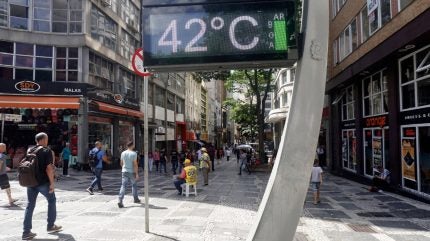
The impacts of rising temperatures on human health, environmental ecosystems and crop yields are well known, but the effects are now being seen on infrastructure too.
Whether situated in 40°C summers in Saudi Arabia or -20 °C Siberian winters, infrastructure is traditionally built to withstand the local environmental and climate conditions. However, the 10 warmest years in the historical record have all occurred in the past decade – from 2014 to 2023 – and this is moving the goalposts.
Moreover, from June 2023 to June 2024, temperatures averaged a significant quarter of a degree Celsius higher than records set only a few years before, and July 2024 was the hottest month ever recorded since global records began in 1850.
As tolerable temperature limits are exceeded, global infrastructure faces cascading risks of damage and widespread failure.
Infrastructure at severe risk from record heat
“Much of our infrastructure systems were built based on a climate of the past, and we are now seeing communities across the globe facing record-breaking heat that is ultimately pushing infrastructure to or past its threshold,” Sabrina Bornstein, US climate resilience lead at Buro Happold, a global integrated consultancy of engineers, designers and advisers, tells World Construction Network. “This can range from public transit cars that are slowed down by railways lines that are too hot to power outages due to the growing demand for cooling during extreme heat events.”
According to Steve Scott, co-founder of GHD Advisory EMEA and the EMEA Future Communities lead at GHD, a global professional services firm providing solutions across digital, engineering, environmental, design and construction, this means that ageing infrastructure is the most vulnerable to extreme heat worldwide.
In a world of interconnected infrastructure, one failure can have a widespread impact. Record temperatures can of course also drive wildfire risk and drought conditions. In 2023, for example, Canada alone had 9.5 million hectares of land burned by July.
Bornstein says: “Damage to housing, coastal airports, docks, and railway lines can all experience loss from this damage that directly impacts economies. On top of this, private-sector investors are less likely to invest in facilities and business models that appear vulnerable to climate change.
“Insurance companies are changing their premiums to adapt to new risk profiles, creating uncertainty across multiple market sectors. These impacts extend to the financial system, threatening the revenues of businesses while increasing the probability of default. Public sector support has therefore never been more important.”
Energy and telecoms infrastructure at front lines of risk
During heatwaves, power grids are under immense pressure as electricity consumption jumps. China’s Sichuan province hit a record 68GW of electricity consumption in 2024, 13% higher than the previous year’s peak this August.
Heat affects the production of electricity and can reduce the output efficiency of solar panels by 10-25%. In 2018, a Swiss nuclear plant reduced its output by 10% due to increased temperatures in the river that cools the reactor. Zambia, a country that is 85% dependent on hydropower, is now investing in a new coal plant as repeated droughts have left cities without electricity.
Transmission is impacted too. According to a 2016 review, the carrying capacity of electric power cables will decrease by up to 6% as a result of record temperatures by mid-century, even as peak summertime loads can increase by up to 15%.
Data centres, the foundation of global online infrastructure, have temperature thresholds maintained by cooling systems. In 2022, UK’s record-breaking heatwave caused Google and Oracle’s London data centres to overheat and cooling systems to fail, forcing them to go offline.
Transport infrastructure faces deformation, damage
All transport infrastructure faces risks of damage from rising temperatures.
Scott explains: “Asphalt concrete expands and even softens under high temperatures, and it leads to buckling and cracking. So, you know, you see the road surface weakening, breaking up, which causes dangerous driving conditions.”
Railways face significant risk from thermal metal expansion leading to operational failures due to overheating, buckling of rails, and even the sagging of overhead electric lines, according to Scott. For example, the 2022 heatwave that recorded temperatures above 40°C in the UK damaged runways, caused lineside fires, buckled roads, power cuts, with some train routes suspended.
Operators are trying to adapt to these new extremes by investing in different materials and design. Margaret Read, director of policy at the UK National Infrastructure Commission, says: “For instance, some new railway projects in the UK are allowing for greater temperature variations by using different types of concrete slab track that can withstand more pressure than standard ballasted track. But this comes at a cost.”
Sean Keyes, CEO of Sutcliffe, a UK-based civil and structural engineering firm, adds that this includes modified asphalt for roads, thermally stable steel for railways, and the use of reinforced concrete to ensure the structural integrity of bridges.
Firms also undertake an operational and maintenance approach for resilience. Scott says of GHD’s work: “We paint the rails white when dealing with extreme heat in the UK. We deploy drones and digital technologies to monitor heat stress within the rail network, which can help you identify which part of the network is weakened in a heat event.”
Urban heat ‘climate-proofing’ is crucial
Bornstein notes that urban infrastructure is “particularly vulnerable” to extreme heat because of the traditional methods of paving with concrete.
“On hot days, concrete can absorb up to 95% of the sun’s energy – becoming too hot to touch and radiating heat on its surroundings,” she says. “Not only does this make it difficult for people to be outside, but it means that other structures are more vulnerable to the heat emitted. In turn, heat is often amplified in developed areas compared to neighbouring rural communities, a phenomenon known as the urban heat island effect.”

According to the Global Commission on Adaptation, several reports show that making existing and new infrastructure resilient to climate stress has a strong business case, with economic benefits outweighing costs by 4:1 on average.
Bornstein says that managing temperature planning must start with understanding how people interact with heat.
“A first step for many communities and regions is a climate vulnerability and risk assessment to understand the exposure and vulnerability of the people, places, and systems most impacted by climate hazards, including rising temperatures,” she explains.
“Heat strategies can include mitigation strategies, ones that reduce the impact of heat on the built environment, and heat management strategies that take into account how to respond to heat waves when they take place. Heat mitigation interventions range from cool materials, including cool roofs, cool pavements and cool walls, to structural shade, equitable tree canopy, and green infrastructure that includes bioswales and rain gardens to name a few.”
Read, meanwhile, points out that rising infrastructural risk is challenging in a context where most key infrastructure such as sewers and rail lines in the UK will still be running in 2055.
“Along with investing in any new infrastructure required, it’s vital to ensure that existing systems can cope effectively with the expected weather impacts from climate change,” she says.
“So, the Commission argues that greater stress testing for different weather scenarios is vital. We have called for UK regulators to work with operators to develop cross-sector stress testing which better identifies interdependencies and the risk of such cascade failures.”
Marc van den Berg, global managing director for investments for Climate Investment, a decarbonisation investor focussed on climate-tech solutions, emphasises the critical importance of technology innovation in heat mitigation.
He says: “For buildings, software ‘platform’ technologies like Asia-oriented 75F are helping operators anticipate heat loads to proactively control temperatures and enhance energy efficiency. Physical heating and cooling technologies also have an important role to play in mitigating the urban heat island effect. For example, in New York City, Gradient Comfort is installing streamlined window-mounted HVAC units that combine heat pump technology and climate-friendlier refrigerant to deliver 30% great energy efficiency compared to traditional systems.”
Structural shifts are needed globally
As oil and gas exploration booms globally despite the COP28 agreement to transition away from fossil fuels, temperatures are only set to rise and set new records in the coming years.
According to Scott, there needs to be a change in the way infrastructure investment is done.
“Investment models are still often based around the hard economic outcome and not the life cycle outcome of things,” he says. “If we want to make things resilient, we’ve got to invest now for benefits in the future. Instead, what we tend to see is that politically and also in investment terms, people want to make decisions that will have an immediate impact and benefit, within a 5-10 or 10-15 year horizon.”
While Scott emphasises that mitigating the climate crisis itself to reduce risk is crucial, he shares three key ways of building resilience – firstly, future-proofing all new projects using innovative technology. Secondly, by optimising the performance and resilience of current infrastructure by using technology and data-driven monitoring and solutions. Thirdly, he says: “To think about nature-based solutions first and really move away from this engineering approach of fighting against nature to engineering approaches that work with nature, because, from a net zero point of view, that’s much better.”
Bornstein emphasises the need for focused action on heat within cities and infrastructure, recommending the appointment of chief heat officers, who are already being hired in North America. By way of precedent, she notes: “Industries have adjusted to environmental changes by implementing ESG officers, directors of sustainability, and more.”
Read concludes: “We have to face the reality that infrastructure can never be 100% resilient to weather extremes. The cost of improving resilience is borne by taxpayers or as billpayers, so it is important that there’s clarity about what the costs are and agreement on how the burden is shared.”



